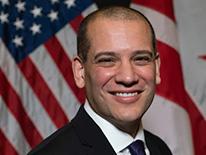Speakers
4 speakers
Date & Time
Apr 5, 2022 2:00 p.m. ET
Webinar
Date: On Demand
Duration: 1 hour
Cost: No Fee
It’s clear that data and information are the keys to preparing and dealing with large scale events. Whether it’s a music festival or the Super Bowl federal, state and local agencies and private sector organizations are working together to prepare for those large scale events.
The preparation starts months, if not years, in advance, and includes tactical and operational strategy planning.
Chris Rodriguez, the director of the Washington DC Homeland Security and Emergency Management Agency, said large planned events, such as the Washington Capitals Stanley Cup winning parade in 2018, included fire, emergency management services, the Department of Transportation at the federal and state levels and dozens of others.
“You want to make sure that those relationships are built and they’re constantly reinforced and nurtured because when you come together, and you have sort of a city state jurisdiction, like the District of Columbia, where there’s 29 different law enforcement agencies, both at the federal and local level, you got to make sure that coordination is strong on unplanned events, like we just had the State of the Union event as a national special security event,” Rodriguez said during the panel discussion Preparing for Large-Scale Events sponsored by Dataminr. “From the Secret Service to the Capitol Police to the Park Police and across the federal government entities, we have great relationships with them. We do tabletop exercises and planning with them in terms of our security posture. We’ve got a good structure in place here. It’s been in place for decades, and we just continued to refine it over time.”
All of the panelists agreed that building and maintaining trust is central to the event’s safety and success.
Chief Benjamine “Carry” Huffman, the acting chief operating officer at U.S. Customs and Border Protection in the Homeland Security Department, said you can’t surge trust during events.
“One of the first things we have to address when we’re involved in is what authorities do we have to do this because that’s not that’s not normally what we are authorized to do. We’re usually asked to participate by another agency, for example, the Super Bowl that was designated as a level one series and the Secret Service had the overall lead for DHS, and so the support requests came from them,” Huffman said. “When it comes to actual strategy of protecting an event, it’s not unlike a lot of things we do a big amount of. For generally a large scale event like the Super Bowl, you got three key things you look at. You need an impedance and denial capability to know who gets in and you isn’t supposed to get in. You need to have situational awareness about what’s going on. That comes from electronic collection methods like cameras or intelligence collections, and you need your relationships because there’s no one agency that does it and you have to be able to cooperate, communicate and transmit data across those lines, which is key to making it successful.”
The situational awareness piece helps create that trust relationship. Federal, state, local agencies and the private sector must partner to collect and analyze data to create that situational awareness.
Jay Humphlett, the executive vice president for public sector at Dataminr, said establishing those formal lines of cross-agency communications is vital to ensure the best information is shared in real-time.
“How do we bring in all of the disparate publicly available information, data sources and how to do that at scale around the globe? We have started to bring in over 250,000 different datasets, and we’re able to look whether it was the trucker disruption up in Canada or the trucker convoy, we’re able to find those critical events,” Humphlett said. “Then, now that we have the information, we push those alerts out to the stakeholders in real time. That’s how we tried to help develop this common picture for all of the stakeholders in the area.”
He added artificial intelligence is key to helping organizations understand the information in real time – finding the needles in the haystack during critical events.
Christopher Paolino, the vice president of strategy and operational performance for the Metropolitan Washington Airports Authority, said they use data to understand how a certain event will impact travelers, airport operations and facilities and the roadways that serve the airports.
“There’s no way to restate planning is as early in advance and as comprehensively as possible, but it’s that flexibility to move our resources to respond to where they need to be when they need to be as we get better information about how conditions are changing,” he said. “The information that we can gather and is shared, as more and more intelligence comes in, is important. We can pre-position assets to the best of our ability. But then, from our standpoint, it’s an interoperability of those assets, how can we quickly move them back and forth, the airports aren’t terribly far apart from each other 26 miles in between the two. But we have to be able to communicate and coordinate across those two, but also that shared communication infrastructure to the region.”
Paolino added that shared communication infrastructure comes partly from the technology that underlies the region, but also from cross functional training that occurs annually.
Humphlett said public and private sector organizations should rely on current and historical data to help influence their situational awareness.
Huffman added the data and the trust relationships create the foundation and then ensuring there are clear operational requirements brings everything and everyone together.
“That’s always a piece that needs to be worked on. You can ask for that information, but it needs to be relevant to what you’re trying to do, and I think that helps do that quite a bit,” he said. “There’s a responsibility on the operator to describe what your collection requirements are, what you are looking for, what’s relevant to you and your mission set and what you’re trying to accomplish. Understanding that relationship is the key, and understanding those collection requirements is important to make sure you’re getting the right stuff.”
Learning objectives:
- Considerations for planning for large-scale events
- Evaluating data for event strategies
- Utilizing mobile alerts and technology
This program is sponsored by ![]()
Complimentary Registration
Please register using the form on this page or call (202) 895-5023.
Speakers

Christopher Paolino
Vice President, Strategy and Operational Performance, Metropolitan Washington Airports Authority

Chief Benjamine "Carry" Huffman
Acting Chief Operating Officer, Customs and Border Protection

Christopher Rodriguez
Director, D.C. Homeland Security and Emergency Management Agency

Jay Humphlett
Executive Vice President, Public Sector, Dataminr
Please register using the form on this page.
Have questions or need help? Visit our Q&A page for answers to common questions or to reach a member of our team.
